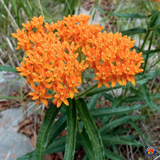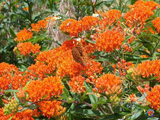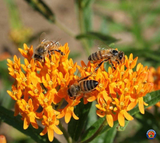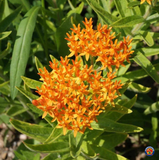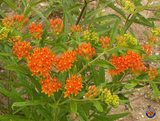40 Butterfly Milkweed Seeds Asclepias tuberosa Native Perennial for Monarchs
Butterfly Milkweed is native to the central and eastern United States and is found in moderate to drier sites. Plants grow to 30 inches tall and have clusters of dark orange to reddish flowers. Butterfly milkweed is very adaptable and non-aggressive, which makes it ideal for home garden use. Plants are host to monarch butterflies and provide nectar to many pollinators.
MORE INFO:
Name: Butterfly Milkweed
Scientific Name: Asclepias tuberosa
Color: Orange
Hardiness Zones: 3-10
Plant Seeds: Outdoors After Frost / Indoors Weeks Before Last Frost
Plant Height: 18"-30"
Plant Spacing: 18 - 36"
Cycle: Perennial
Bloom Season - Summer
Light Requirements: Full Sun, Partial Shade
Soil & Water Preferences: Average
Other: Attracts bees, birds, & butterflies,
Sowing: In late fall, direct sow butterfly milkweed seeds just below the surface. Germination will take place in the spring, after the last frost. When the seedlings appear, thin to the strongest plant; seedlings usually do not survive transplanting, since they resent any disturbance of their roots. For spring planting, mix the seeds with moist sand and refrigerate for 30 days before direct sowing.
Growing: Young plants should be watered until they become established; mature plants can tolerate drought, and the roots will be damaged by excessively wet soil. This plant grows slowly, and it may take 2-3 years to produce flowers. Though not invasive, this plant will eventually spread if left to drop its seed. The flowers attract bees, butterflies, and hummingbirds. Deer avoid this plant. If aphids become a problem, dislodge them from the plant with a strong stream of water.
All multiple orders of the same seed are put in the same bag. For example if you order 500 beefsteak tomato seeds x 3 then 1500 seeds will be put in the same bag. We do not send out 3 individual bags with 500 in each. This goes for all seeds unless they are listings of different seeds.
NOTE: ALL GROWING INFO AND INSTRUCTIONS ARE ON ITEM PAGE.
If you can’t find germinating and instructions online you can find them on the item page. Our goal is to save money everywhere we can so we can pass those savings on to you.
MORE INFO:
Name: Butterfly Milkweed
Scientific Name: Asclepias tuberosa
Color: Orange
Hardiness Zones: 3-10
Plant Seeds: Outdoors After Frost / Indoors Weeks Before Last Frost
Plant Height: 18"-30"
Plant Spacing: 18 - 36"
Cycle: Perennial
Bloom Season - Summer
Light Requirements: Full Sun, Partial Shade
Soil & Water Preferences: Average
Other: Attracts bees, birds, & butterflies,
Sowing: In late fall, direct sow butterfly milkweed seeds just below the surface. Germination will take place in the spring, after the last frost. When the seedlings appear, thin to the strongest plant; seedlings usually do not survive transplanting, since they resent any disturbance of their roots. For spring planting, mix the seeds with moist sand and refrigerate for 30 days before direct sowing.
Growing: Young plants should be watered until they become established; mature plants can tolerate drought, and the roots will be damaged by excessively wet soil. This plant grows slowly, and it may take 2-3 years to produce flowers. Though not invasive, this plant will eventually spread if left to drop its seed. The flowers attract bees, butterflies, and hummingbirds. Deer avoid this plant. If aphids become a problem, dislodge them from the plant with a strong stream of water.
All multiple orders of the same seed are put in the same bag. For example if you order 500 beefsteak tomato seeds x 3 then 1500 seeds will be put in the same bag. We do not send out 3 individual bags with 500 in each. This goes for all seeds unless they are listings of different seeds.
NOTE: ALL GROWING INFO AND INSTRUCTIONS ARE ON ITEM PAGE.
If you can’t find germinating and instructions online you can find them on the item page. Our goal is to save money everywhere we can so we can pass those savings on to you.






